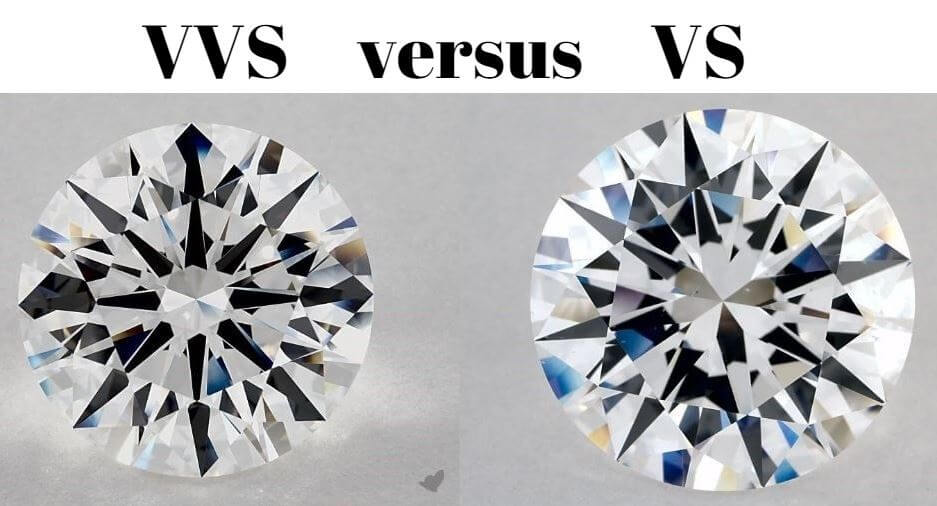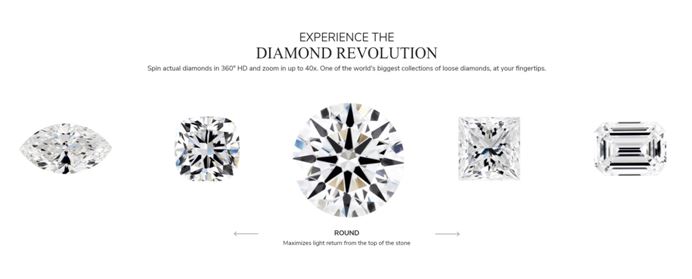The VVS diamond (Very Very Slightly included), as well as the VS diamond (Very Slightly included), differs in clarity, and, if all is equal, they can vary significantly in the price. However, having an idea of these differences can help you make a smart purchase.
Why you need to know the difference: VVS versus VS Diamonds
If you have been in the act of comparing diamonds for an engagement ring purchase, there is no doubt that you are already aware of the GIA 4Cs of diamond quality, which is Clarity, Color, Cut, and also Carat Weight.
You are aware that diamond size and quality are related to price. That is simply because larger diamonds that are graded high on the clarity, color, and cut scales are rarer, so they are more expensive. But in comparing precious stones of equal size, you may have at one point, or the other discovered even the smallest differences in grades – often impossible to identify with the naked eye and can as well have a significant impact on price.
Moreover, we’ll focus on the clarity of diamond grades – most notably, on two categories of grading that seem to generate a lot of online questions and discussion: VVS and VS.
There are two main subcategories within each of these grades that represent the simplicity by which the defining clarity features can be seen when the precious stones are examined face-up under 10 × magnifications.
Nevertheless, both a VVS precious stone and VS will have clarity features that are in almost all cases and cannot be seen with an ordinary eye. Yet, the differences in price between these two precious stones can be as high as 30%.
For instance, according to a diamond pricing sheet, 2018 used by most wholesalers and retailers, a 1.00 carat, D color, a VVS1 diamond can be 20–30 percent more expensive than a VS1 stone of the same intensity and weight. A 1.00-carat G-H color, a VVS1 diamond, can be 15–20 percent also more costly than a comparable VS1 or VS2 diamond.
In case you’re purchasing a precious stone of this quality, the distinction in cost can be critical. That is the reason it pays to find out about these two clarity grade classes and what goes into deciding the difference in clarity between a VVS precious stone and a VS jewel.
A VVS diamond, what is it?
As shown in the above lucidity grade outline, a VVS precious stone contains minute inclusions that range from incredible difficult (VVS1) to very difficult (VVS2) to see at 10× amplification. Frequent additions that may set the VVS grade include:
Pinpoints, needles, inward clouds or graining that are noticeable just through the structure (the part of a cleaned gem that is below the girdle) or are trying to see face-up at 10× magnification (VVS1)
Needles pinpoints inward graining or clouds that are exceptionally hard to see face-up at 10× amplification (VVS2)
Minute surface-reaching inclusions such as a cavity, chip, bruise, feather, bearding, indented natural, etc. Therefore, a diamond with inclusions that is eye-visible would not receive a clarity grade of VVS1 or VVS2.
A VS diamond, what is it?
A VS precious stone contains minor inclusions that range from difficult (VS1) to some degree simple (VS2) to see at 10× magnification. Full range sorts of addition are possible; however, they should be small compared with the size of the jewel.
Typical inclusions may set the grade, which includes some crystals, knots or distinct clouds, or minor surface-reaching the features, for example, cavity, feather, or indented natural. In sporadic cases, a VS stone that is large may contain eye-visible inclusions.
Blemishes and inclusions: Diamond Clarity
The clarity of a diamond is referred to as the external and internal feature of a precious stone procures in the journey from development through cutting, cleaning, and every day wear. Some erroneously call these features “flaws” or “marks.” The right term is “clarity qualities,” and they add to each precious stone’s distinctive character.
There are two different sorts of clarity attributes: inclusions and blemish. Imperfection is an external component that is restricted to the outer part of a precious stone. An example would be additional features, naturals (remainders of the first expensive stone surface), clean lines, and scraped areas on facets junctions.
An inclusion is an internal element that is either wholly encased inside a precious stone or stretches out into the jewel from its surface. Standard addition is crystals, feathers, clouds, pinpoints, (groups of pinpoints), internal graining, needles, or indented naturals (that is, physicals that extend below the surface of the diamond) for photographs and well-detailed descriptions of these and other clarity features.
Blemishes typically only affect the clarity grade in the primary two classifications (Flawless and Internally Flawless), while inclusion affects all classes. For VVS and VS precious stones, at that point, we’ll center around integration.
Precious stones with few or no clarity qualities are rare. In this way, all things being equal, jewels with less inclusion – or little, less visible inclusions – are typically more costly than diamonds with more inclusions – or progressively significant, more obvious ones. That is the reason why VVS precious stones will cost more than VS diamonds.
Be that as it may, a clarity grade is more than letters and numbers. To comprehend the distinction between the VVS and VS reviews, how about we take a look at how GIA grades precious stones and what the various classifications represent for your jewel.
How GIA decides clarity grades for precious stones
In the clarity grading framework of the GIA, 10× is the stipulated magnification adopted to determine a diamond’s clarity grade. While a GIA stone grader will make use of her trained eye and a microscope at high magnification to examine a diamond, she then makes the final grading call based on what she can see utilizing a standard 10× jeweler’s loupe.
In landing at a clarity grade, the grader takes into consideration five factors:
Size: When every single other component is equivalent, the bigger the examination or flaw is comparative with the size of the precious stone – and, along these lines, the more visible it is – the lower the jewel’s clarity evaluation will be.
Number: When every other factor is equal, the more inclusions, impressions of considerations, or imperfections visible face-up at 10× magnification, the higher their impact on the clarity evaluation will be.
Area: This refers to the situation of blemishes or inclusion. The closer joining is to the focal point of the table, the colossal impact it will have on the clarity grade.
Alleviation: This refers to the complexity between the inclusions or flaws as well as the precious stone. For the most part, the more the clarity characteristics differ in splendor, darkness, or coloring from the jewel, the more obvious it is, and the more critical its effect on the clarity grading will be.
Nature: Here, the grader takes a look at the kind of character and what innate impact it has on the presence of the precious stone. As it were, a few inclusions or flaws can have a more critical effect on the clarity grade than others.
After the GIA grader has identified all the diamond clarity qualities also taking into consideration the five factors recorded over, the precious stone is assigned a clarity grade depending on the following criteria:
| Clarity Grade | Visibility at 10× Magnification |
| Flawless (FL) | No inclusions and no blemishes visible at 10× magnification |
| Internally Flawless (IF) | No inclusions and only insignificant blemishes visible at 10× magnification |
| Very Very Slightly Included (VVS1 and VVS2) | Minute inclusions that range from extremely difficult (VVS1) to very difficult (VVS2) to see at 10× magnification |
| Very Slightly Included (VS1 and VS2 ) | Minor inclusions that range from difficult (VS1) to somewhat easy (VS2) to see at 10× magnification |
| Slightly Included (SI1 and SI2) | Noticeable inclusions that are easy (SI1) or very easy (SI2) to see at 10× magnification but usually, are not eye visible |
| Included (I1, I2, and I3) | Obvious inclusions visible at 10× magnification – and often seen with the unaided eye |
A VVS diamond or a VS diamond– So, which should you choose?
Since you know the technical difference between a VVS jewel and VS clarity precious stones, you may ask yourself: Is a higher clarity grade worth the cost? From one viewpoint, in practically all cases, the lower (VS) clarity won’t be evident to the ordinary eye. Then again, the higher (VVS) clarity represents a precious stone that is nearer to perfection – and rarer – than the lower-clarity stone.
For a few, the choice may be driven by the cut and state of the precious stone. Step-cut jewels, including critical rectangular aspects, similar to emerald cuts, take a look at higher clarity grades, like some splendid cuts like heart and marquise. For other people, the choice might be symbolic. A high-clarity precious stone may represent the irregularity and immaculateness of extraordinary love.
Be that as it may, choosing the best precious stone for you represents a progression of decisions between cut, clarity, coloring, and carat weight. While transparency is necessary, only it won’t ensure an excellent precious stone. If the financial limit is a thought – and it is for most wedding rings purchasers – the reserve funds acknowledged with VS clarity may get you a bigger precious stone or one with a superior color or cut.
Conclusion
A significant point to recall while buying a diamond is consistently to purchase GIA ensured precious stones. If you have just begun your examination on precious stones, you may, without a doubt, have gone over the 4 C’s of stones: clarity, coloring, cut, and carat. Moreover, you may likewise have discovered the immediate connection of these characteristics and the size of the jewel to its value range.

